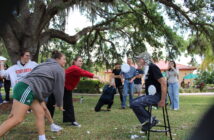By Alora Peters, Editor-in-Chief
“It will not go down as one of the greatest weeks in Saint Leo history.”
Members of the Saint Leo University community cannot help but agree with Fran Reidy, the vice president of athletics, recreation, and wellness: the announcement is far from being one of Saint Leo’s better moments, as community-wide shock followed in the wake of a Feb. 16 press release.
In the release, Saint Leo announced a series of changes and cuts to various programs in all areas of collegiate life, including academics, athletics, and student activities.
“People have lost their jobs,” said Reidy. “Student-athletes feel disenfranchised. It’s the last thing that anybody wanted to happen.”
Notably, the university plans to “discontinue operations” at eight of its 16 satellite campuses. Students attending the affected education centers – located in Charleston, S.C.; Joint Base Charleston-Naval Weapons Station, S.C.; Columbus, Miss.; Corpus Christi, Texas; Jacksonville, Fla.; Lake City, Fla.; Ocala, Fla.; and Mayport, Fla. – will transition to the WorldWide online program.
Additionally, three degree programs will be eventually discontinued: the Bachelor of Arts in International Hospitality, the Bachelor of Arts in Human Services, and the Master of Science in Human Services.
Mariana Navarrete, a Saint Leo alumna who graduated in 2022, stated that she was drawn to the university because of her interest in the Bachelor of Arts in Global Studies – another recently discontinued program.
“They cut my major before I graduated,” said Navarrete. “That was kind of a tipping point … I literally came to Saint Leo to swim and study that specific major.”
Navarrete was told that she would still be able to graduate with her chosen degree, a similar experience to the students in the three soon-to-be-discontinued programs. However, due to the lack of available global studies courses, her classes were largely drawn from other departments, such as political science, sociology, history, and economics.
“It changed all of my classes,” said Navarrete. “It was very shocking.”
In conjunction with the academic program changes and center closures, the Feb. 16 press release also noted that, “a total of 111 faculty and staff positions were eliminated.”
Staff positions were eliminated in a variety of areas – ranging from student success to military resources to student club management – and faculty positions were ended in programs experiencing low enrollment among students, including all non-English language programs.
Perhaps the most widely discussed notice in this press release was the announcement that six of Saint Leo’s 23 NCAA Division II athletic teams would be cut at the conclusion of their respective seasons.
Confusion and panic ensued following the release, as athletes and other members of the Saint Leo community speculated which teams would be discontinued. Many were upset the university disseminated this information online and through social media before having a conversation with the affected athletic teams.
“When I saw that they just posted the article without even telling the athletes … that was very unprofessional, I think,” said Navarrete, who competed on the women’s swim team during her time at Saint Leo. “The coach had no clue, and the athletes even less.”
Graduates like Navarrete also noted the stress that many Saint Leo athletes must have felt receiving the news in the midst of competitions over the weekend.
“I couldn’t imagine [being]in the position of those athletes and just having that news of ‘My program is being cut’ … because of operational issues that are not their fault,” Navarrete said. “I think a lot of athletes feel powerless about the decision.”
While the communication of the teams’ upcoming discontinuation was problematic, other factors complicated the matter.
The disparity between the initial press release and the revelation of the affected teams stemmed from the timing of changes affecting other departments and areas of the university.
“Part of the challenge was that there were some things in motion with the whole university,” said Reidy. “Our value of Integrity said we needed to announce all of the plans in the initial announcement … There were some pieces to the equation besides the athletic piece. There were people traveling to the centers to tell people [about the closures].”
Many affected staff positions were eliminated immediately on Feb. 16. However, the fact that many of the affected teams were travelling and competing at this time meant that it was impossible for a face-to-face conversation between the university and the athletes.
“It left some teams that were on the road in a bad situation … I still think calling teams up while they were on the road and telling them would have been just as bad,” said Reidy. “If we didn’t announce anything about athletics in the initial announcement, but came back this week and said, ‘Oh, by the way, we forgot something in that,’ people would have said we weren’t transparent from the beginning.”
Additionally, the timing of the final vote of the Board of Trustees left little time for advance communication.
“The Administration and the Board of Trustees … really, really debated this question,” said Reidy. “Some of the very final decisions were not reached until last Wednesday [Feb. 15], less than 24 hours before the announcement.”
On Feb. 21, five days following the initial press release, Saint Leo released the statement officially announcing which six teams would be cut at the conclusion of the spring season: the men’s and women’s track and field, cross-country, and swim teams.
Following this second announcement, many student athletes expressed concerns, hurt, and frustration, as reported in interviews with major news outlets, such as ABC Action News and Fox 13.
Additionally, members of the Saint Leo community were shocked to hear that these particular teams were cut, given the amount of success seen in Saint Leo’s track, cross-country, and swim teams.
Notably, the men’s cross-country team has brought home four SSC championship titles, and the women’s cross-country team brought home three. The men’s swim team holds the university record for most All-Americans, with a total of 25; the women’s swim team tied for second place, with a total of 13 All-Americans. Furthermore, each of these four teams boast a significant number of NCAA championship appearances, with women’s cross-country making six, men’s cross-country making seven, men’s swim making 11, and women’s swim making 12.
For Navarrete, it was sad and frustrating to see her team and fellow swimmers succeed and continually pursue athletic excellence without much funding from the university or recognition from other students, especially in comparison with other athletic teams on campus.
“I knew they were going to cut the program at some point,” said Navarrete. “That’s why I left and graduated early … It was very sad. [Saint Leo] recruited amazing swimmers.”
To lose talented student-athletes is what has led many members of the Saint Leo athletics community to feel that the decision to cut these specific six teams was “personal.”
“I want people to realize that it’s not as cut and dry as we would like,” said Reidy. “I don’t want to pit teams against each other: ‘Why my team and not that team?’ We have the right people here … That’s what makes this very difficult: wonderful coaches, wonderful student-athletes. [It’s] through no fault of their own that our enrollment has dipped.”
Lack of funding coming from lack of enrollment – particularly from the decrease in enrollment through Saint Leo’s education centers and WorldWide online program – means that every area of collegiate life at Saint Leo will suffer from a decreased budget.
“In Division II, athletics does not make money. So, it becomes a question of, ‘what is acceptable for our institution to spend on athletics?’” said Reidy. “We had a number that we had to meet.”
A decrease in budget given to the athletics department meant reductions in scholarships, salaries, staffing, and teams.
“There was great debate over ‘how many programs?’” said Reidy, explaining that the initial projection of cuts into the athletics department would have resulted in the loss of even more teams.
“The original number that we were given to target would have [resulted in]far more than six,” he said.
The main expense currently incurred by the athletics department is scholarships.
“Our biggest number is in scholarships,” said Reidy. “A scholarship is worth around $40,000. So, if a team has three scholarships, that’s $120,000 right there.”
Even with the valiant efforts of Saint Leo’s Lions to fundraise for their teams, it would be nearly impossible for a team to sustain itself without aid from the university.
“When you say that a program with scholarships, and coaches, and coaches’ benefits, is $400,000-500,000, that’s a lot for a team to think they are going to raise every year in order to fund their program,” said Reidy. “Certainly, fundraising is needed by everybody. All of the teams do it. All of the teams are very good at it. But, if we were expected to fundraise all of the money needed to run all of the teams … Impossible.”
Consequently, even returning athletic teams will feel the effects of the budget restraints in the future, with less money available from the university for athletic scholarships.
“This year, we had almost $9 million in financial aid go to student athletes,” said Reidy.
Additionally, teams’ operational budgets – which were significantly reduced last year – will remain at these reduced levels for the time being.
Another factor that went into the process of deciding which athletic programs to cut was the quality of the athletics facilities available.
“The reality is that our swimming pool is 53 years old and we never know from one day to the next if it is going to be okay,” said Reidy. “If that pool became unusable in the middle of a season, that would be a problem.”
Reidy said that the university has discussed the possibility of building an aquatic center in conjunction with various entities in Pasco County – including the school board, county commissioners, and parks and recreation – in order to make a new pool possible for the Saint Leo athletes.
“It was going to be about $3 million to renovate our pool,” Reidy said.
Additionally, Saint Leo does not currently have a stadium or designated practice arena for its track and field teams. The result is that the university is already unable to provide for these athletes the highest quality training experience and equipment.
If Saint Leo is able to return to its former budget and address these lacking areas, the athletics department would hope to restore the men’s and women’s swim, track and field, and cross-country teams to the roster.
Reidy stated that, when he first started working at Saint Leo over 25 years ago, the university only had 10 sports.
“The way that it was built up last time was, as the school did better, each area of the university grew and prospered,” he said. “We built this thing once. We’re going to try to do it again.”
In the meantime, the university hopes to provide the directly affected athletes with as many resources as possible during this transition period.
“There is a number out there, that 72 athletes were impacted,” said Reidy. “Twenty-four are graduating, so the number is more like 48. About half of them are on scholarship, and half are not on scholarship.”
Students with athletic scholarships on the affected teams who choose to remain at Saint Leo will be able to retain their athletic scholarship for one year, up to tuition. The intent is to allow junior and senior athletes to be able to finish their education at Saint Leo; additionally, freshman and sophomores who are unable to transfer to another institution for the 2023-2024 academic year would be provided with more time to search for an alternative.
Additionally, Saint Leo wants to take advantage of all of the construction and development taking place around University Campus to generate more revenue for the athletic programs. Things like sponsorships, advertisements, and rentals of Saint Leo’s fields and facilities are all being considered as sources of revenue generation.
“We do have great facilities here, so I think we need to take advantage of that,” said Reidy. “If we could make … $500,000 through field rentals, that would be huge.”
Furthermore, with limited athletic scholarships available, the university hopes to offer more in terms of competitive club sports in order to continue offering athletic experiences, provide opportunities for connection, and increase enrollment and retention of students.
Currently, a proposal for a rugby club team is in the works. Club soccer teams for men and women are also in discussion. Saint Leo has already experienced success with its sporting clays team and its ice hockey team.
Aside from rebuilding financially, one of the more difficult issues the university will need to grapple with, moving forward, is maintaining positive relations with members of the Saint Leo community.
Navarrete stated that, given everything that has happened in the past year since her graduation, returning to Saint Leo will be very difficult for her.
“I just can’t process those things,” she said. “Most of my time, I was at the pool … The reason I would have come back is literally to watch swim meets, and see how the team was evolving.”
Nonetheless, alumni like Navarrete do hope that students currently facing this difficult situation maintain a hopeful and optimistic attitude.
“Things happen for a reason. Maybe not the best reason,” said Navarrete. “But don’t drown in sadness … Look for options. Everything will fall into place. Don’t be afraid of change … People will hit you with things that are not in your control, and you will just need to adapt to it.”
Likewise, Reidy hopes that the university will rally, recover, and learn from what happened.
“We’ve overcome challenges before at Saint Leo,” said Reidy. “We’re a gritty group, and we have some really smart people, and we’re going to find a way to get through this, and build our athletic program back … I’m confident that we can find a path forward.”






